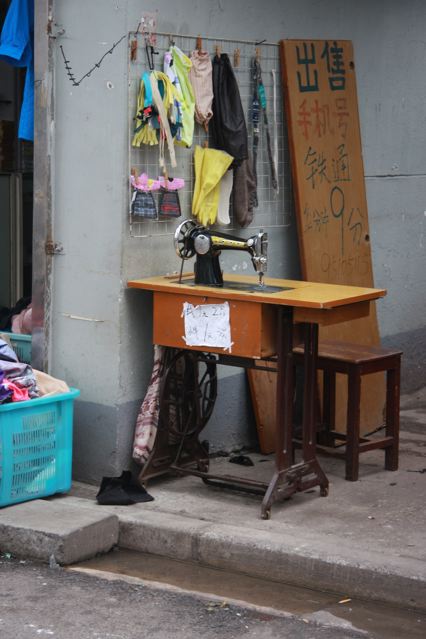
Yet, only a few of the old farmers are left. Most of their former homes have been chopped up, each room rented to a migrant family for RMB 300 or 400 a month. The old people have gone. Shanghai’s suburbs now belong to the young.


In the heart of these makeshift migrant communities, village roads mutate into new urban streets. Micro businesses - a mixture of stores and stands – cluster together: a mattress shop, a tiny one room video arcade, a motorcycle fix it shop, stores stuffed with plastic buckets, basic household goods and other random odds-and-ends.

Scattered throughout are food stalls. Some sell street snacks, others vegetables, meat, oil and grains. The most basic trader has nothing but a plastic bucket containing a single fish.

As workers on construction sites and factory floors, migrants function as the essential underpinning to China's new cities. Yet, as the micro entrepreneurs of a vast informal market, they have constructed a shadowy realm – intensely vibrant and dynamic - that exists outside all urban plans.

Despite vigorous attempts at gentrification, this unplanned shadow economy has yet to be contained. It spills out of the urban fringes, erupting as an uncontrolled and uncontrollable periphery, even within the urban core.
Wander in the older neighborhoods and streets give way to alleyways. Whole zones are pedestrian-only, as roads become too narrow and chaotic for cars to navigate. On the street everything is for sale - food of course, but also animal pelts, curios, and sex toys. Barbers, tailors, dentists operate with the minimum of equipment - a few chairs, a table, a mirror, a bench.

During the planned economy era, it was the lack of an open food market that - more than anything else - locked the population in place. Without the ration tokens supplied by the state, people couldn’t eat. Today migrants from all over the country hawk their regional delicacies.
Outside Shanghai’s university gates one finds a cacophony of street food vending. Baozi are stacked high in bamboo steamers. Handmade carts, rigged up with either coal or gas, are used to cook pastries and skewers of all kinds, stinky tofu, fried noodles and ‘pot-sticker’ dumplings. In winter deliciously fragrant sweet potatoes are sold out of huge metal barrels. During the hot months durian pieces and fresh coconuts are for sale.


Even in the fanciest parts of town the grey market invades. Outside the villas, fashion boutiques and trendy coffee shops of the former French Concession, mobile peddlers sell plants and pottery. The informal recyclers call out for unwanted used goods. Carts appear on street corners piled high with vast collections of household goods. Residents stop by to pick up a hanger, a clothing peg, a piece of string. Nearby the baozi stands and bing sellers do a roaring trade as office workers line up to grab breakfast on the run.




Yet, migrants do more than service white-collar workers. China’s informal economy is also at the cutting-edge of a high-tech futurism whose innovations no one can predict.
Even the poorest of migrant communities has an Internet bar. Migrants are also at the forefront of the shanzhai phenomenon – a new playful piracy that has blurred the line between imitation and innovation.
By mutating existing products for local markets, adding new features, transforming designs and radically lowering costs, shanzhai technology has led to the celebration of an indigenous DIY culture in urban China, with a huge disruptive potential. To quote cyberpunk author William Gibson “the street finds its own uses for things.”

Urban planners tend to associate development with the attempt to ‘clean up’ the chaos and disorder of the informal economy. City inspectors are given license to chase down vendors, seize their carts and keep their earnings. Throughout Shanghai vibrant street markets have been bulldozed and paved over. Shiny glass malls filled with chain stores and fast food franchises now stand in their place.

Yet, if Shanghai is to fulfill its ambitions to create the city of the future, it must pay heed to the shadowy culture of its newer, younger, and poorer population. The innovation out of which the future emerges comes not only from the grandiose visions of planners but also from the unanticipated disruption of the street.




















